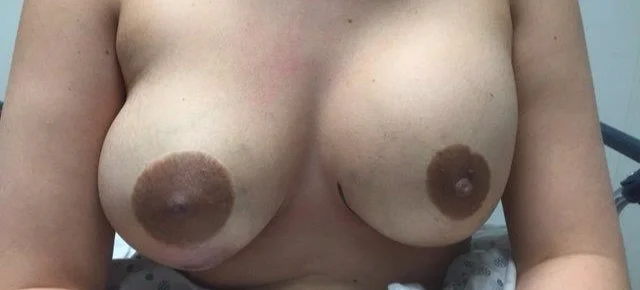BEFORE & AFTER PHOTOS
*DISCLAIMER: This site contains graphic & surgical images that may be disturbing to some viewers.
This site is intended for individuals over the age of 18.
**Please note that none of the images posted throughout this site have been enhanced or photoshopped.








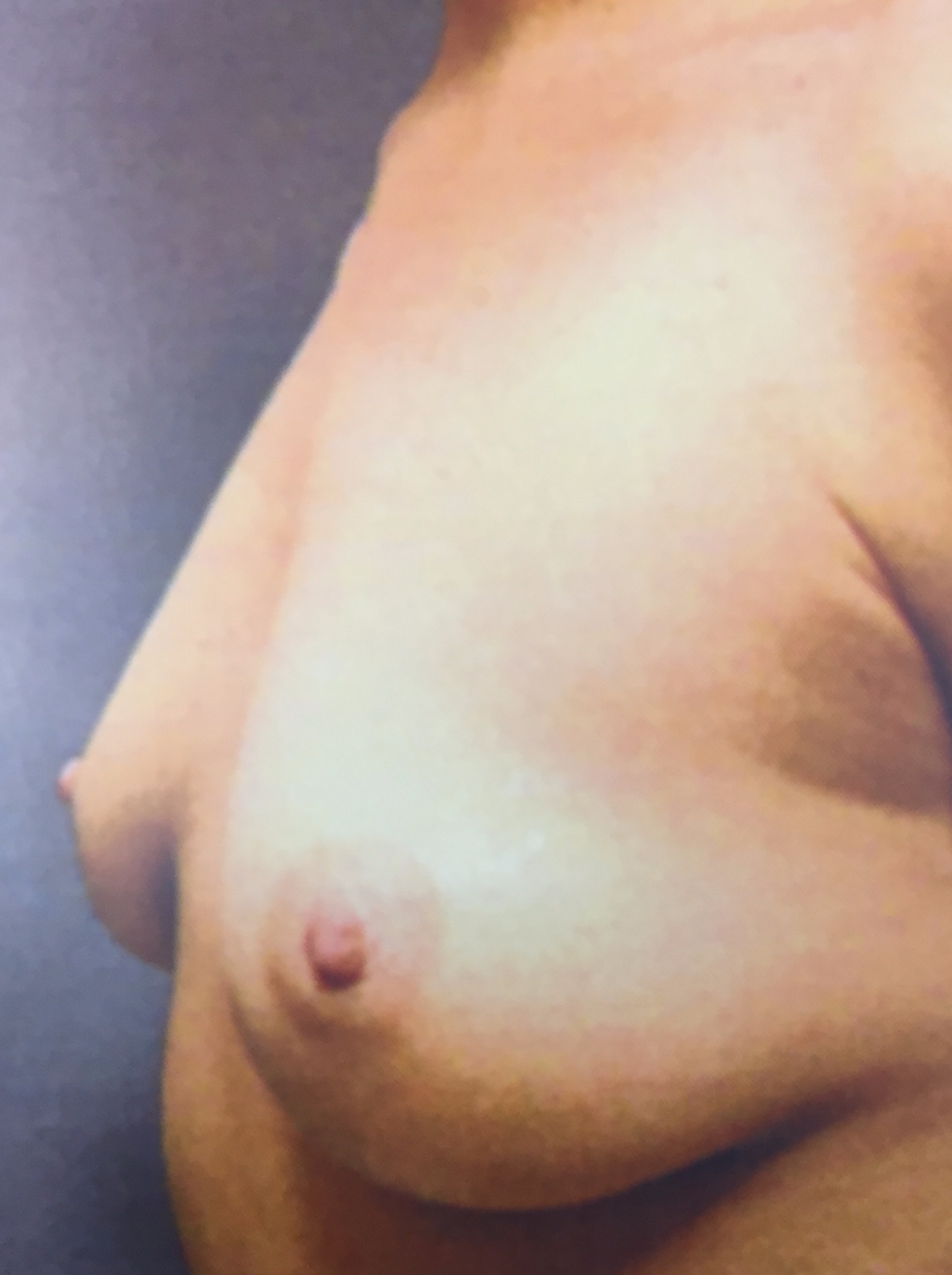

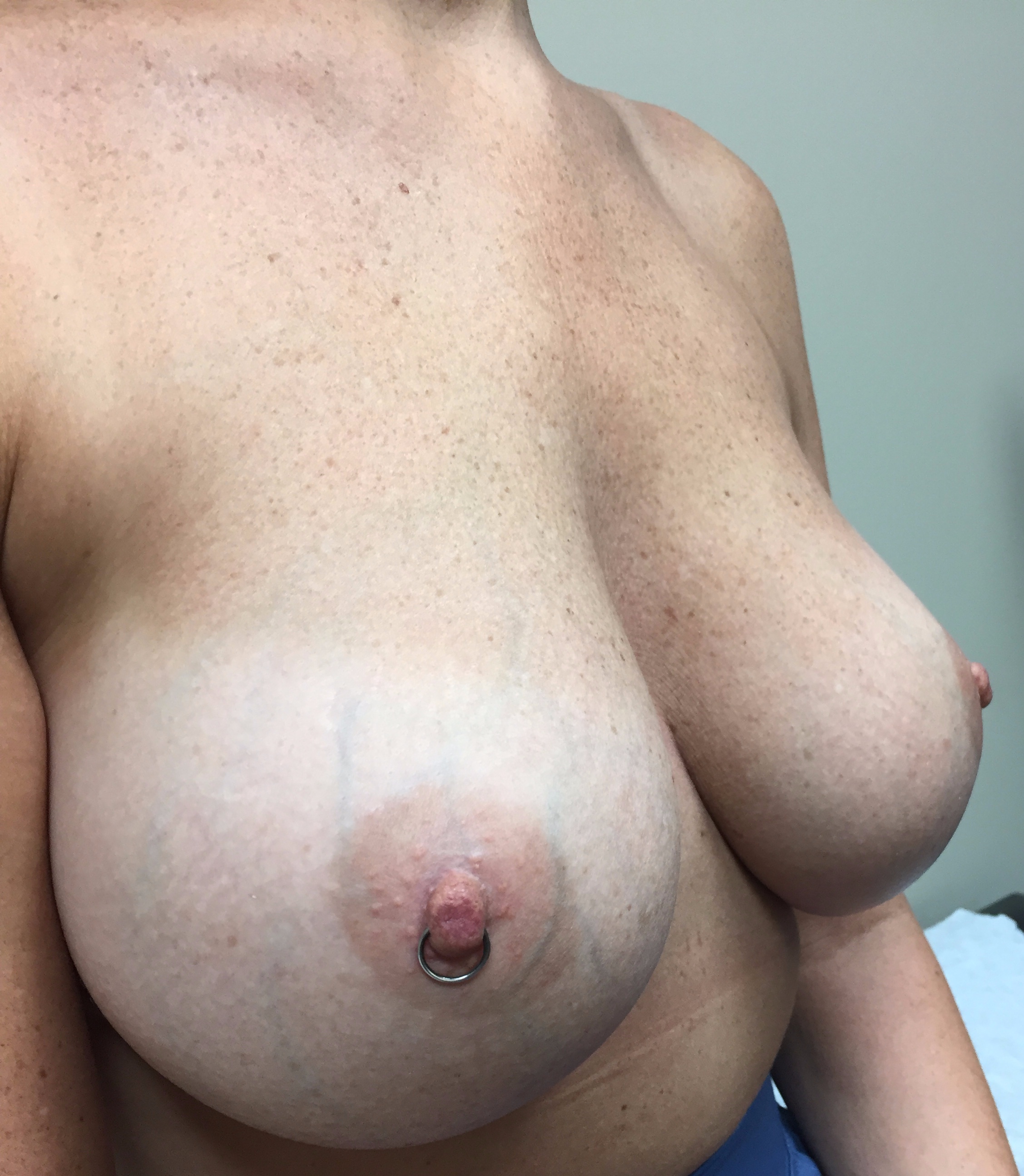





















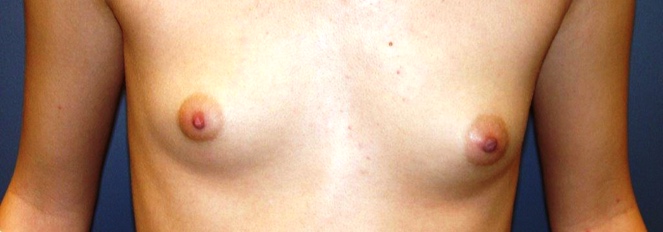
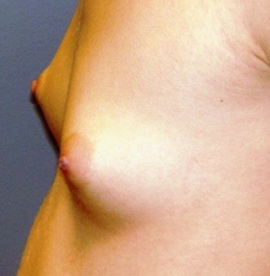




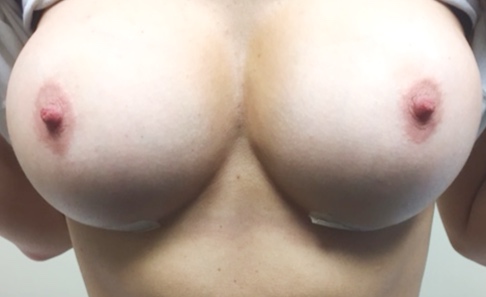
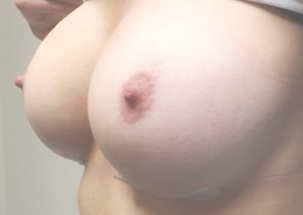




















































before the surgery:
What is the perfect breast?
Symmetry (both breasts are very similar). 40% of breast volume lies above the nipple areolar complex, and 60% lies below. The nipple areolar complex is at the apex of the breast mound, with a gentle lower and lateral curve of the breast mound meeting the chest wall at a defined crease, which matches the opposite breast.
What is a Breast Augmentation?
This is a day surgery procedure (the patient goes home the same day) done with the patient asleep, (General Anesthesia) where an implant (either saline or silicone) is placed behind the breast (either above or behind the chest muscle which is behind the breast).
Please see www.pclsc.ca under Breast Augmentation.
Who can have a Breast Augmentation?
The youngest age is after full breast growth is complete (age 18-19); there is no limit to an older patient, except for the patient's general health (in order to have a General Anesthetic).
What are the breast implant choices?
There are two primary choices:
Saline Implants:
This is an empty plastic silicone sack that is placed in the space surgically created behind the breast, and then filled with saline from an intravenous bottle. This implant tends to ripple more, and is generally overfilled to smooth the ripple and therefore feels firmer. *Please refer to the patient image descriptions.
How would I know if my Saline Implant leaked?
Saline Implants have a very uncommon potential to leak. If that happened, the saline would be absorbed like drinking a glass of water, with no harm to your health. The implant would deflate, and would require replacing. If this ever happens, your breast would change in size and shape over a 24 hour period. Contact the surgeon immediately for an assessment. There is no schedule of replacement for saline implants. They can last for many decades.
Smooth Round Silicone Implants:
This implant is often referred to as a "gummy bear" implant. If you were to cut it in half, the two halves would stay together, similar to splitting a gummy bear in half. These implants have different profiles, ranging from low, moderate, moderate plus, high and extra high. If you placed each of these different implants on a table, the amount that each implant projects off of the table, is LEAST with a low profile, and MOST with an extra high profile. This implant has less rippling and feels softer (if you were to hug someone). This implant also has a finite life expectancy (like a tire on your vehicle). Changing the implant every 10 years is recommended. There is a cost to replacing the implant every 10 years. *Please refer to the patient image descriptions.
Shaped Textured Implants:
This is a cohesive gel silicone implant that has a textured surface on its skin, and can be is a tear drop shape or a round shape.
The idea of the textured surface is to decrease the likelihood of Capsular Contracture Formation. This implant, however, tends to fix to the chest wall, it does NOT move like a normal breast would and has the potential for malposition. It can displace or rotate, where the tear drop projected part of the implant is no longer in the correct position.
Studies suggest that this implant does NOT decrease the Capsular Contracture rate. Because the textured implant fixates to the chest wall, it does NOT move like a natural breast, has potential for malposition and with the higher cost, this implant was a less popular choice for most patients.
Recently, the Canada Health Protection Agency has removed Textured implants as an option for both Cosmetic and Breast Cancer Reconstruction, as a result of the need for further investigation into an extremely rare cancer that my have an association (Breast Implant Association - BIA) with Textured Breast Implants called Anaplastic Large Cell Lymphoma (ALCL). Patients with textured implants that have a sudden change in their breast, with sudden spontaneous swelling of the breast, should see their family Physician or Plastic surgeon for further investigation. The investigation would involve a breast specific MRI and possible sampling of fluid around the implant for CD30 testing. If the investigation is suspicious, the recommendation is to have the textured implant and the entire breast capsule removed by your Plastic Surgeon.
In recent years, important data has been collected internationally that has contributed greatly to our understanding of these textured
devices. Specifically, a very rare condition known as breast implant associated anaplastic large
cell lymphoma. (BIA-ALCL) has been described in a very small number of patients with textured
surface implants. BIA-ALCL is almost exclusively associated with textured implants, particularly Allergan textured implants.Textured implants were, until recently, approved by Health Canada for use in breast reconstruction and
breast augmentation, and may have had the advantages of being more likely to remain in a stable position
in the body and to be less visually detectable than smooth implants sometimes are. Recent
research has shown a link between textured implants and a rare form of cancer called BIA-
ALCL. Please note that BIA-ALCL is not a breast cancer and, if detected early, is very treatable.
There is currently no recommendation to have these implants removed and/or replaced unless
you are diagnosed with the disease.
The early warning signs of this problem which, if present, must not be ignored. In the majority of
reported ALCL cases, the initial presenting symptom is a distinct swelling of the affected
breast. You would notice this as a substantial size change on the affected side. The breast might
feel tense and firm. Usually the swelling comes on rapidly, over several days or weeks, not over
months or years. Typically, this occurs on one side only, but in exceptional cases, it can occur in
both breasts
If you notice any of these changes or symptoms, the appropriate action is to call the Plastic Surgeon's
for a consultation. There are some investigations that can be done to determine whether you have ALCL.
You may also be interested to read the FAQ at:https://www.plasticsurgery.org/patient-safety/bia-alcl-summary/frequently-asked-questions .
How can I decide which implant is the best for me?
The look of both saline and silicone implants are the same. What patients have to decide is their personal preference in terms of how the implant feels (softer with silicone; firmer with saline), and the duration of time before changing the implants (10 years for silicone; decades or more for saline). The decision is, therefore, not the look, which is the same for both, but rather, the feel of the implant and the duration that the implant lasts.
If either the saline or silicone implant fails within the first 10 years, the manufacturer will cover the cost of a new implant.
Does a larger implant cost more?
No. The cost for a small or large implant, of the same type, is the same. There may be a difference in the cost of a saline compared to a silicone implant.
How long do breast implants last? Do I need to change them?
Silicone implants last up to 10 years. The manufacturer recommends changing the implant to a new implant every 10 years.
Saline implants have no schedule of replacement. The indications to replace the saline implant is the rare event that they leak and deflate, or, the patient wants them removed for aesthetic reasons.
How do I decide how big to make my breasts?
This is a very personal choice that a patient has to make. The common A, B, C, D etc. labels for bra sizes is not consistent among bra manufacturers. Dr. Giuffre can assist you in this decision using photographs, implants you can try, and the “rice” test.
Rice Test: The size of the implants are measured in cc’s. Filling a ziplock bag with a measured amount of uncooked rice, and placing the zip lock bag in a non padded sports bra in front of your breast, will give a close representation of what your breast would look like with the cc’s of rice in the zip lock bag.
1 ounce = 30 cc’s.
1 cup= 8 ounces= 240 cc’s.
Keep increasing the amount of rice in the zip lock bag until you reach a bra size that you like. Tell Dr. Giuffre the volume (in cc's) of the rice in the zip lock.
What happens if I choose an implant and later I find it is too big or too small?
It is very important that the patient spend some time selecting an implant size that they will be happy with. The use of the rice test, along with internet, or magazine photographs of breasts (unclothed) will help you decide the desired breast size. If you select a silicone implant, once inserted at surgery, it cannot be adjusted without a second surgery to replace the implant completely to a larger, or, smaller size. This is a costly redo.
If the patient selected a saline implant, this can be adjusted to be larger or smaller, after the original implant surgery. Under local anaesthetic (freezing), fluid can be added to the saline implant to increase the breast volume, or, fluid can be removed to decrease the breast volume. This is far less costly.
One breast is a bit smaller than the other. Can this be fixed?
It is unusual for the breasts to be identical. They often differ in size and shape. Adjusting implant size can often correct a minor size symmetry issue. If the size and shape and nipple height are dramatically different between the breasts, then additional surgical options would be considered at the time of breast implantation, like a breast lift and or breast reduction.
*Please see FAQ Breast Lift & FAQ Breast Reduction
The surgical options and associated risks would be thoroughly discussed by Dr. Giuffre before a surgical procedure is done.
I've heard bad stories about silicone implants. What is the story?
Patients who had Silicone implants prior to1992 had no advice on the duration of the implant life. These implants were filled with a liquid silicone similar in consistency to pancake syrup. No advice was given, by the manufacturer to the surgeon, regarding when the implant should be replaced, and therefore, surgeon and patients incorrectly assumed they would be good for life. This was incorrect. These implants all fail and leak creating potential problems within the breast. This leak is often discovered during routine breast surveillance examinations like routine mammograms and breast ultrasound examinations.These implants should be removed. Most health care jurisdictions will cover the cost of the removal.
Can silicone affect my health?
Recently, there has been considerable traffic on Facebook and other social media platforms, regarding “Breast Implant Disease.” There are an enormous range of human disease symptoms accredited to the Silicone implants, with numerous testimonials and anecdotal stories. At present, the medical science to date, has found no association of human disease to silicone contact. Please refer to the Mayo Clinic and John Hopkins Studies links provided, discussing the scientific studies related to silicone and human disease.
The findings and conclusions to all of these investigations were that silicone is immunologically inert and does not affect human health. Not withstanding, if a patient wished to have her implants removed, this can be done under a local (implant only) or general anesthetic (the implant and the scar around the implant is removed and sent for histopathology).
What a broken and leaking implant can do is allow the syrup like silicone to infiltrate into the breast and surrounding tissues creating lumps (silicone granulomas). This makes breast examination and breast surveillance for breast cancer difficult. The silicone itself does not cause breast cancer, but makes detection more difficult because of the formation of these lumps (granuloma).
These older implants were taken off the market in 1992. There was a moratorium on using silicone breast implants from 1992-2002 in North America. After 2002, a new silicone implant was designed and are currently used today called cohesive gel implants (gummy bear implants) which have an anticipated life expectancy of 10 years. It is highly recommended that patients using the current silicone gel implants for both cosmetic and or reconstruction purposes change their implants every 10 years.
How strong are the implants? Do I have to be careful with sports or other activities?
Both saline and silicone implants are very strong and can withstand forces created by rigorous sports activities. A patient can resume rigorous sports activities 6 weeks following breast augmentation surgery.
I don't like the shape of my breasts. Can this be fixed with a Breast Augmentation?
Breast shape can change as a result of a weight change,(increase or decrease), pregnancy, breast feeding, and getting older (gravity). Sometimes the breasts don’t develop normally, or, one is different than the other. The surgical consultation and examination with Dr. Giuffre will provide surgical options to correct asymmetry caused by differences in breast size and shape.
My breasts are quite droopy. Can you fix this with a Breast Augmentation?
This depends on the severity of the droop (called ptosis). If it is minor, a breast augmentation can often correct the ptosis. (See first set of attached photos of Patient M below). If the droop is more significant, then a breast lift would be required (see Breast Lift) along with a breast augmentation (if the patient also wanted larger breasts). If the patient wanted only the breast ptosis correction without enlarging the breasts, then only a breast lift would be done.









My nipples are at different heights. Can you fix this with a Breast Augmentation?
No. This correction requires some form of breast lift surgery.
the operation:
Do I have to go to sleep (General Anaesthesia) to have a Breast Augmentation?
A General Anaesthetic is required in all cases.
How long does the operation last?
Approximately an hour to an hour and one half.
Where is the surgery done?
Dr Giuffre uses a private surgical suite adjacent to his Meadowlark Health Centre Office(#176) for his cosmetic procedures.
Please See: www.pclsc.ca
Where is the incision made?
The most common incision is placed in the natural crease formed where the breast meets the chest wall (inframmary crease). The length of the incision is 3.5-4 cm. Other incision sites are, in the armpit, or, around the lower half of the nipple areolar complex.
Will there be a scar?
Yes. Any incision in the skin, regardless of where in the body, will heal with a scar. The scar will mature, (going from red, to pink, to white, and then softening) which can take 1-2 years. Medical paper tape placed directly over the incision, changed weekly for 3 months, will help speed up the process of scar maturation.
Will I have stitches?
Yes. They are under the skin and will absorb, (disappear by themselves) therefore, no sutures are removed.
The implant is placed behind the breast. Does it go in front or behind the muscle?
If the breast implant is placed in a surgically created pocket behind the pectoralis major muscle, this is referred to as a sub muscular implant. This implant position creates a more natural breast appearance.
Less commonly, if the implant is placed in a surgically created pocket behind the breast tissue but in front of the muscle, this is referred to as a sub glandular or sub mammary implant. This gives the appearance of a more surgically augmented breast.
Please visit www.pclsc.ca "Breast Augmentation"
*Please refer to Patient N (subglandular implant) and Patient O (submuscular implant) below.











additional patient images of breast augmentation:


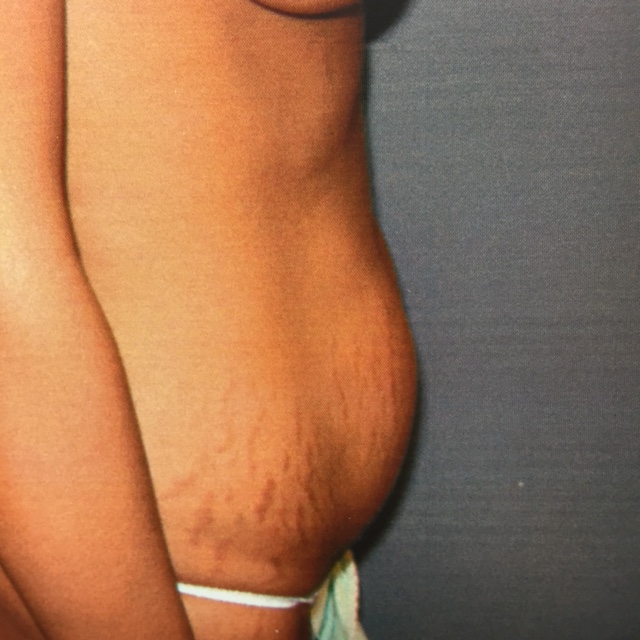


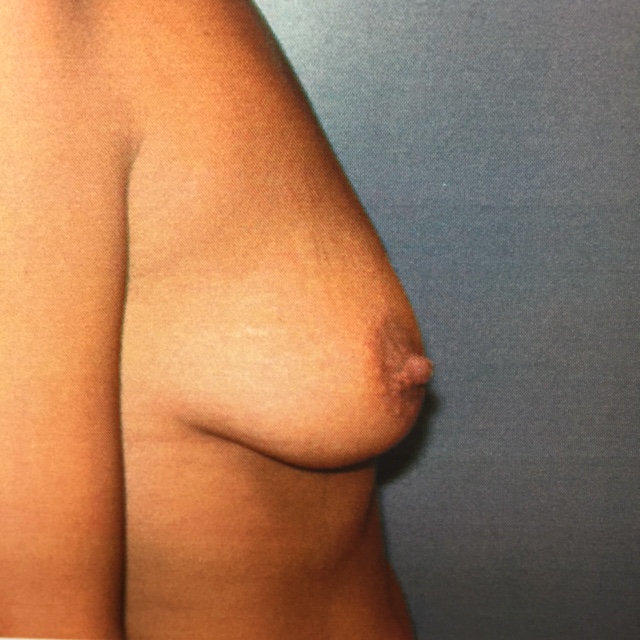
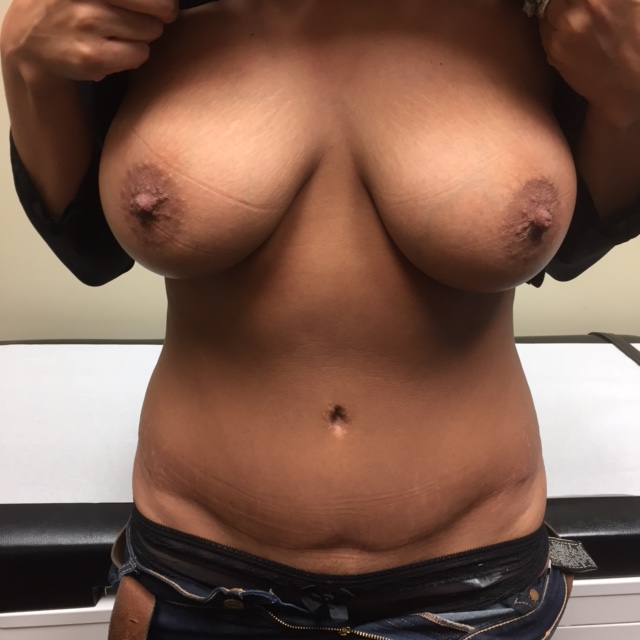
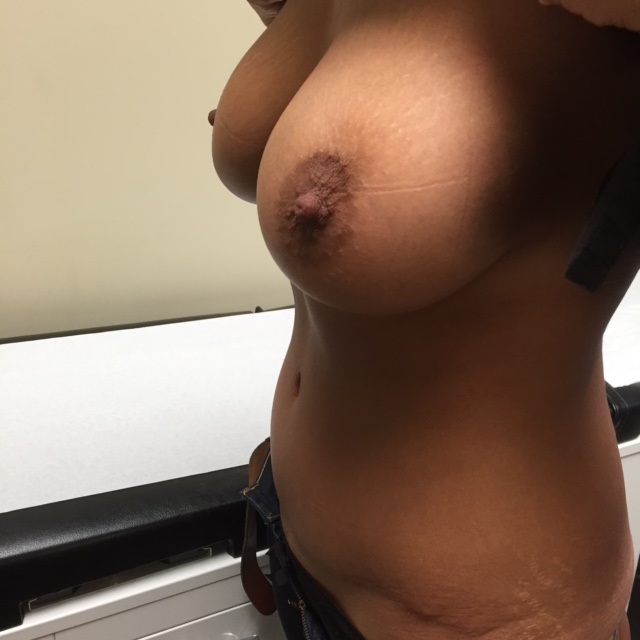













Is the procedure painful?
Before waking from the surgery, Dr Giuffre will inject a long acting local anesthetic into the breast area to decrease any immediate breast discomfort from the surgery. When the freezing wears off, both the sub glandular and sub muscular implant operation will require post operative analgesic medication (pain killers) for up to a week. The discomfort typically subsides after the first two days following the surgery. Patients taking prescription pain medication should not drive a car or operate machinery or sign significant documents while taking this medication.
Do I go home the same day as surgery?
Yes. You will have to arrange a ride and aftercare with a responsible adult. You are not permitted to leave unaccompanied or in a taxi.
I live out of town. Should I stay overnight?
If your driving distance from Edmonton exceeds 90 minutes, you should make arrangements to stay overnight in Edmonton. The surgical centre does not have an overnight care facility. You will then be seen the following day for dressing removal and assessment by Dr. Giuffre and his staff.
Can I contact my surgeon the day or night of surgery if I have a concern?
Yes. Dr. Giuffre provides his home phone number to his cosmetic patients in case there is a patient concern. In the rare instance that a patient requires hospitalization, Dr. Giuffre has admitting privileges to all of the major hospitals in Edmonton.
When do I see my surgeon after surgery?
You will be seen the day following surgery by Dr.Giuffre and/or his nursing staff, and again within the week following your surgery by Dr Giuffre. Further follow up arrangements will be made at that time.
When do I wear a bra?
You will wake up from surgery with a bra on. The bra will be removed the following day when you have the first dressing change. You can then wear the bra provided, or your own, as comfort allows. If you prefer wearing an underwire bra, these may be uncomfortable during the first 6 weeks of recovery.
When can I shower?
You are able to shower the next day, following the first dressing change. It is okay to get the incision wet.
In which position can I sleep?
Any position that is comfortable.
Do I need to massage the breasts after surgery?
No, this is not necessary.
Aggressive manipulation of the breast within the first 6 weeks of surgery may produce bleeding in the breast pocket created for the implant.
When can I resume relations with my partner?
Your partners hands must keep off of the breasts for 6 weeks.
What should I do to minimize scarring?
Vitamin E and Bio oil are not proven to positively impact scar healing. Dr. Giuffre recommends medical paper tape on the incision for 3 months, changed weekly by the patient.
How long should I plan to be off work?
The typical time off work is one week. If your work is extremely strenuous and involves heavy lifting, the time off work will be longer.
How long am I off sports and my workouts?
No sports or strenuous activity for 6 weeks. Patients are to avoid strenuous activity that increases the heart rate and blood pressure. This could produce bleeding inside the breast pocket. The rule of thumb is, if you are sweating from the activity, you are over doing it and you are placing yourself at risk.
I do aggressive sports. How sturdy are the implants?
Very sturdy. There are no restrictions on sports after 6 weeks. Dr. Giuffre discourages heavy weight lifting that directly exercise or strain the pectoralis major muscle, if you have sub muscular implants.
Professional weight lifters will most often choose to have their implants placed in front of the muscle so as to not disturb their muscles. Once they are finished their career, they may choose to have the implant switched to the sub muscular location which gives a more natural looking breast.
The risks:
What are the risks of doing a Breast Augmentation?
With any surgery there are surgical and anesthetic risks.
Aside from the rare risks of an anesthetic event, some of the general and specific surgical risks for this procedure would include:
Scarring
Infection (If this occurs, removal of the implant may be necessary)
Extrusion (Please refer to Extrusion Patient T and Patient U below)
Capsular Contracture (Please refer to Capsular Contracture Patient W below)
Sensation change to the breast or nipple
Discomfort
Time off of work and exercise
Implant failure or rejection (Extrusion Images below)
Excess scarring around the implant (Capsular Contracture Images below)
Asymmetry
Bleeding (hematoma)
Cost for Implant change
Please note that this list is not complete. During the consultation with the patient, Dr. Giuffre will outline and explain each of the risks in detail.
extrusion




capsular contracture






Can I have a mammogram after a Breast Augmentation? How often?
A mammogram can be done after a breast augmentation. It is recommended that the patient wait a year after the surgical procedure before doing a mammogram. It is recommended that a patient contemplating a breast augmentation have a mammogram done prior to the surgical procedure. This is particularly important if there is a family history of breast cancer.
In Alberta, if there is a family history of breast cancer, the first mammogram should be done at age 40. If there is no family history of breast cancer, then age 50. Every woman should examine their breasts for lumps monthly, one week after their menstrual period. This is best accomplished in a shower. If a patient feels anything suspicious, contact your Family Doctor immediately for further assessment, investigation and referral.
Can I have a Breast Augmentation before getting pregnant and having a family?
Yes. The implant is placed behind the breast or behind the muscle under the breast. It does not interfere with breast function. The implant will not interfere with the natural response to the hormones of pregnancy and breast feeding. Because of the changes that occur to the breast during pregnancy and breast feeding, some women's breast size and shape will change.after pregnancy and breast feeding.
Can I breast feed after a Breast Augmentation?
A Breast Implant does not interfere with breast feeding.
Am I at higher risks of developing breast cancer if I have a Breast Augmentation?
No, you are NOT at higher risk of having breast cancer if you have a Breast Augmentation.
It is recommended that the patient wait a year after the surgical procedure before doing a mammogram. It is recommended that a patient contemplating a breast augmentation have a mammogram done prior to the surgical procedure. This is particularly important if there is a family history of breast cancer.
In Alberta, if there is a family history of breast cancer, the first mammogram should be done at age 40. If there is no family history of breast cancer, then age 50. Every woman should examine their breasts for lumps monthly, one week after their menstrual period. This is best accomplished in a shower. If a patient feels anything suspicious, contact your Family Doctor immediately for further assessment, investigation and referral.
Recently, the Canada Health Protection Agency has removed Textured implants as an option for both Cosmetic and Breast Cancer Reconstruction, as a result of the need for further investigation into an extremely rare cancer that my have an association (Breast Implant Association - BIA) with Textured Breast Implants called Anaplastic Large Cell Lymphoma (ALCL). Patients with textured implants that have a sudden change in their breast, with sudden spontaneous swelling of the breast, should see their family Physician or Plastic surgeon for further investigation. The investigation would involve a breast specific MRI and possible sampling of fluid around the implant for CD30 testing. If the investigation is suspicious, the recommendation is to have the textured implant and the entire breast capsule removed by your Plastic Surgeon.
In recent years, important data has been collected internationally that has contributed greatly to our understanding of these textured
devices. Specifically, a very rare condition known as breast implant associated anaplastic large
cell lymphoma. (BIA-ALCL) has been described in a very small number of patients with textured
surface implants. BIA-ALCL is almost exclusively associated with textured implants, particularly Allergan textured implants.
Textured implants were, until recently, approved by Health Canada for use in breast reconstruction and
breast augmentation, and may have had the advantages of being more likely to remain in a stable position
in the body and to be less visually detectable than smooth implants sometimes are. Recent
research has shown a link between textured implants and a rare form of cancer called BIA-
ALCL. Please note that BIA-ALCL is not a breast cancer and, if detected early, is very treatable.
There is currently no recommendation to have these implants removed and/or replaced unless
you are diagnosed with the disease.
The early warning signs of this problem which, if present, must not be ignored. In the majority of
reported ALCL cases, the initial presenting symptom is a distinct swelling of the affected
breast. You would notice this as a substantial size change on the affected side. The breast might
feel tense and firm. Usually the swelling comes on rapidly, over several days or weeks, not over
months or years. Typically, this occurs on one side only, but in exceptional cases, it can occur in
both breasts
If you notice any of these changes or symptoms, the appropriate action is to call the Plastic Surgeon's
for a consultation. There are some investigations that can be done to determine whether you have ALCL.
You may also be interested to read the FAQ at:
https://www.plasticsurgery.org/patient-safety/bia-alcl-summary/frequently-asked-questions
Will I lose sensation in my nipples after a Breast Augmentation?
There is a specific nerve that goes to the nipple that provides sensation and creates an erect nipple when you are cold. That nerve is not in the anatomic field when a breast augmentation is done, unless there is an unusual anatomic variant. As a general rule there is a very small percentage (<1%) of patients that comment on a nipple sensation change. The sensation change in the nipple could either increase, (due to the increased projection of the breast) or decrease (less common) following a Breast Augmentation.
the complications:
My friend had a Breast Augmentation and one of her breasts went hard. What went wrong?
Your body reacts to any implant (knee, hip, breast etc.) by putting a thin layer of scar tissue around the implant we call a capsule. A small percentage of women will have more scar tissue around the implant than normal. In this population of women, there can be an extensive amount of scar tissue that develops around the implant called a "capsular contracture." This can cause pain, distortion and asymmetry of the breast. If it occurs ,it often requires a second operation to remove the excess scar tissue to correct the deformity.
capsular contracture






What is a double bubble deformity?
This is an uncommon deformity which occurs in a breast after a breast augmentation where the breast crease at the bottom of the breast (Inframammary fold) sits high so that the distance between the nipple and the crease is short. If the patient wants larger implants, the crease must be lowered to accommodate the larger implant. If the surgeon makes the incision in the patient’s original crease (too high) and then attempts to make room for the larger implant below the crease, a double bubble will result; the patient’s original inframammary fold makes the first crease and bubble, and the second bubble is the crease made where the implant rests at the bottom of the breast. The placement of the incision at the bottom of the breast is critical, in order to prevent this deformity. This problem requires further surgery to correct.
double bubble complication





My friend had a Breast Augmentation and one of her breasts dropped. What went wrong?
This can happen if the pocket created to accommodate the implant is made incorrectly. This deformity would require a surgical correction. It is called an inferior drop out.
I have had a Breast Augmentation in the past. Do I need to have it redone?
If you have had a saline implant and are happy with the size and shape of your result, you do not have to have the surgery redone.
If you have had a silicone implant on or after 2002, you should have the implant changed at the 10 year mark following your original breast augmentation. If you are happy with the size, an implant exchange can often be done under local anesthetic.
If your implant is silicone and surgery was on or before 1992, it is likely your implant is leaking or ruptured.
Patients who had Silicone implants prior to 1992 had no advice on the duration of the implant life. These implants were filled with a liquid silicone similar in consistency to pancake syrup. No advice was given by the manufacturer to the surgeon regarding when the implant should be replaced and therefore patients incorrectly assumed they would be good for life. This was incorrect. These implants all fail and leak creating potential problems within the breast. This leak is often discovered during routine breast surveillance examinations like routine mammograms and breast ultrasound examinations.These implants should be removed. Most health care jurisdictions will cover the cost of the removal.
If you have had silicone implants on or before 1992, it is very likely the implants are leaking and have ruptured. These older style implants were never designed to last for decades. The more modern cohesive gel implant used since 2002 have a life span of 10 years.
A mammogram, breast ultra sound or MRI will confirm the rupture and leak.
Dr. Giuffre recommends that a broken implant be removed. Please contact the office for a consultation.
If your implants are the newer cohesive gel implant variety, the integrity of the implant can be assessed by mammogram, breast ultra sound or MRI. The most accurate is an MRI.
If you decide you want larger implants that require a new larger pocket, then this would require a general anesthetic.
Sometimes the original pocket is large enough to accommodate a larger implant without the need to fashion a new larger pocket, in which case, an implant exchange to a larger implant could be done, often under local anesthesia.
Can I use the fat (fat graft) from other parts of my body to enlarge my breasts?
There are some centres experimenting with using only the patients fat to augment the breast. It is not considered standard of care for breast augmentation. Long term results will need to be evaluated. This technique is used primarily to assist in improving the contour of an already reconstructed breast following breast cancer surgery.
Are there before and after pictures?
Yes.
Every patient that Dr. Giuffre operates on for cosmetic reasons will have a preoperative photograph taken. At the 6 week check up with Dr. Giuffre, his patients are given an 8 x 10 preoperative photograph. Postoperative photos are also taken in some instances.
the followup:
How often do I need to come back for a checkup after surgery?
Postoperative visits include a 24 hour visit, a 1 week visit, and a 6 week visit. If there are any patient concerns, Dr. Giuffre provides his home phone number for patient's direct access. After the 6 week visit, if there are any future requests for an appointment, they are made directly with Dr. Giuffre's office and an expedited visit is arranged.
I no longer have access to my original surgeon. What can I do?
For cosmetic or reconstructive concerns, patients are invited to contact Dr. Giuffre's office (780-428-7737) for an appointment. He does not require a referral and there is no charge for the consultation.
I had a Breast Augmentation with another surgeon and I am unhappy. What can I do?
It is always wise to re-consult with your original surgeon in order that he can assess you and your concerns. If that fails or you are still unhappy with your options, you can always seek a second opinion. Dr. Giuffre would communicate your concerns with your original surgeon in order to facilitate a resolution.
I had a Breast Augmentation in another country. I have a problem. What can I do?
For cosmetic or reconstructive concerns, patients are invited to contact Dr. Giuffre's office (780-428-7737) for an appointment. He does not require a referral and there is no charge for the consultation.
I had a Breast Augmentation years ago. My breasts are changing and have lost their youthful shape. What can I do?
This can happen from weight change, pregnancy and breast feeding, aging, and menopause. It can also occur secondary to an out of date implant and capsular contracture. A consultation with a Plastic surgeon is recommended to review the cause and options for improvement.
I had a Breast Augmentation in the past. I want to be bigger. What can I do?
A repeat consultation is necessary. There are multiple options that would be discussed after review of your history and examination.
I had a Breast Augmentation before I had children. After my babies and breast feeding, my breasts have changed and have lost their shape. What can I do?
A consultation is necessary. There are a number of surgical options that could include a breast augmentation, a breast lift, and/or a breast reduction, or any combination of these to recreate a youthful, aesthetically attractive breast.
*Please see FAQ Breast Lift & FAQ Breast Reduction
I had a Breast Augmentation. I don't want the implants anymore. I want to go back to my natural non augmented breast. What can I do?
A consultation is necessary. Your breasts and implant type and location will be assessed. The surgical options may be as simple as just removing the implant under local anesthetic or more complicated requiring a general anesthetic to remove the implant and all of the surrounding capsular scar tissue around the implant.
I had silicone breast implants years ago. I am worried my silicone implants are leaking or ruptured. I recently went for a mammogram and a breast ultrasound. I was told my implant is broken (leaking or ruptured). What does this mean? What should I do?
Patients who had Silicone implants prior to 1992 had no advice on the duration of the implant life. These implants were filled with a liquid silicone similar in consistency to pancake syrup. No advice was given by the manufacturer to the surgeon regarding when the implant should be replaced and therefore patients incorrectly assumed they would be good for life. This was incorrect. These implants all fail and leak creating potential problems within the breast. This leak is often discovered during routine breast surveillance examinations like routine mammograms and breast ultrasound examinations.These implants should be removed. Most health care jurisdictions will cover the cost of the removal.
If you have had silicone implants on or before 1992, it is very likely the implants are leaking and have ruptured. These older style implants were never designed to last for decades. The more modern cohesive gel implant used since 2002 have a life span of 10 years. A mammogram, breast ultra sound or MRI will confirm the rupture and leak. Dr. Giuffre recommends that a broken implant be removed. Please contact his office for a consultation.
If your implants are the newer cohesive gel implant variety, the integrity of the implant can be assessed by mammogram, breast ultra sound or MRI. The most accurate is an MRI.
Financing:
Does the public health care system cover any of the costs of a Breast Augmentation? What about my private Insurance?
Alberta Health Services will cover breast reconstruction for patients who have been treated for breast cancer. They do not cover breast surgery for aesthetic reasons, even with a family doctor referral or a psychiatric or psychological referral.
Private insurance may cover the cost. Please contact your insurance company for written confirmation of coverage.
Can I use the costs of a Breast Augmentation as a tax deduction?
CRA eliminated the use of cosmetic surgery as a tax deduction a number of years ago. Unless you can demonstrate the procedure is a promotional cost for your business, it is not tax deductible.
If there is a medical need, confirmed by your doctor, you may be able to deduct the cost with a letter from your doctor outlining the medical need/necessity for the procedure, along with the receipt for the surgery.
Can I finance the costs of the surgery? How do I do this?
Dr. Giuffre does not provide in house financing for cosmetic procedures. There are a number of companies across Canada that will finance cosmetic surgery, similar to car financing or mortgages. Please refer to the links provided on the Home Page for this information. Dr. Giuffre has no financial or business relationship or affiliation with any of these companies.
If something goes wrong, do I have to repay for the operation?
You do not have to pay for the treatment of an immediate complication. In the unusual event that there is a problem with your original surgery, such as a capsular contracture, or breast deformity, you do not have to pay for the correction.
Should you change your mind after having decided on a breast size, and already having had the procedure done with the implant size you chose, there would be a cost to change the implants to a different size.
Are the implants guaranteed?
Yes. Both saline and cohesive gel silicone implants are guaranteed against rupture for 10 years. If that occurred, the manufacturer will cover the cost of the actual implant provided you use the same manufacturer’s implant. Implants from a different manufacturer are not covered by the original manufacturer.
How much does the operation cost?
The cost of cosmetic surgery is covered entirely by the patient. The one fee would include the cost of the anesthetist (who provides the General Anesthetic), the cost of the implants, the rental of the operating room and equipment, the rental of the recovery room and equipment, the staff, including the nurses and administration staff, and the surgical fee. The cost will vary depending on the duration of the procedure, the type of implant chosen and the quality and sophistication of the surgical facility where the surgery is done.
The fees will be discussed at the time of consultation, with Dr. Giuffre, after the patient has made their procedure and implant choices.
There is no obligation to proceed with surgery following the consultation. The patient is referred to our websites, and is invited back for a second consultation if need be. Our office will endevour to expedite a surgical procedure to accommodate both business and family obligations.
All fees are receipted.
What about having my Cosmetic Surgery in another country where it is cheaper?
There is a current trend to have surgery out of your country where the surgery may be cheaper.
We call this "Tourist Surgery."
There are a number of additional risks to do this which include:
the Surgical skill, experience, licensing and education of an unknown surgeon.
Canada has very strict rules and requirements to be a licensed Plastic Surgeon (FRCS(C)) in our country. Your Plastic Surgeon has completed an undergraduate degree (4 years), an MD degree (4 years), a Fellowship Degree in Plastic Surgery (5 years) and often a post Fellowship (1-2 years).
A "friend" is not a good reference, nor is glitzy advertising.
The use of off market breast implants (not approved by the regulatory bodies like the Canada Health Protection Agency, or the FDA in the USA). These implants are substandard, not guaranteed and are unreliable.
The safety, sterility and equipment quality including anaesthesia machines in the hospital or private surgical suite; this may lead to increased risk of infection and anaesthetic risks.
Post operative care is limited to the time you spend in their country. If you have a complication, to see your original surgeon, you will have to fly back or see a new surgeon in your own country.
If you have an unsatisfactory result, you will have to fly back to see your original surgeon or find a new local Plastic Surgeon. The cost of the repair may exceed what you originally paid, and the final result, fixing a mistake, is often not as good as it could have been, had the surgery been done correctly the first time.
After accounting for the accumulated costs of the air travel, hotel, surgery and post operative care, the perceived cost savings may not be significant.
If you have a severe, life threatening complication, Alberta Health Care will cover the medical costs for your care. Correcting the reconstructive problem as a result of the complication would be the patient's financial responsibility.
